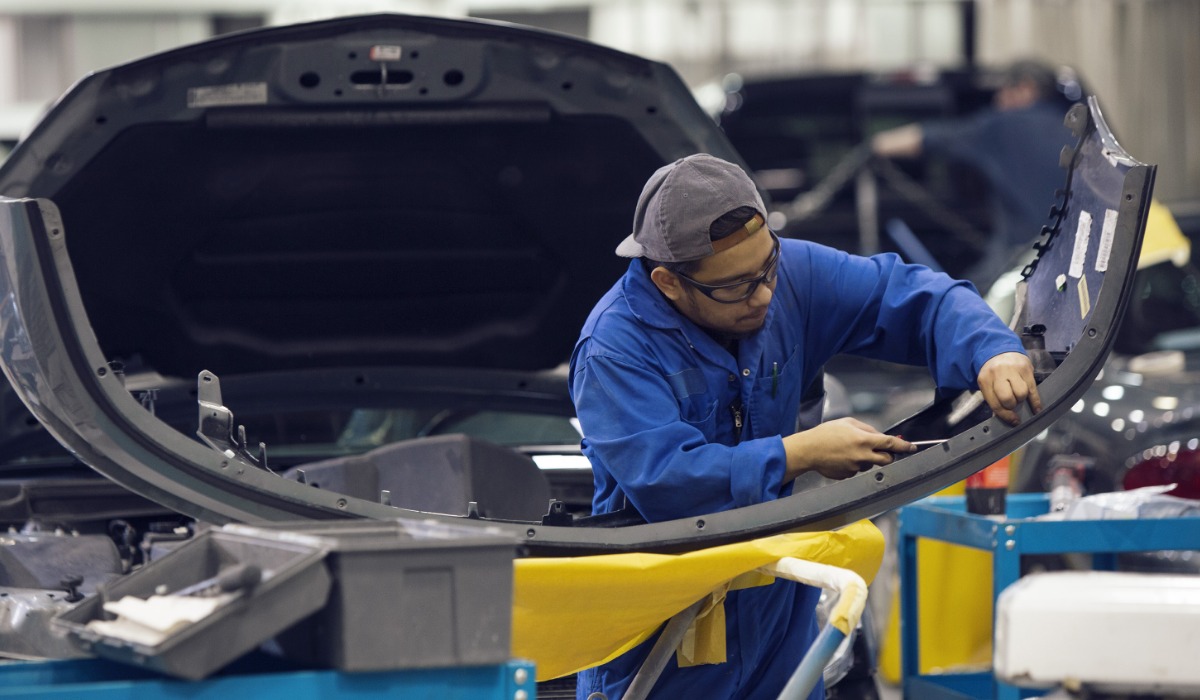Overview
Learn to repair and replace damaged motor vehicle structures, body parts, interior and exterior finishes.
If you're creative and like being hands-on while performing precise work, you'll enjoy working in the auto body trade. In Alberta, auto body journeypersons may specialize as Auto Body Preppers, Repairers, Refinishers or Technicians.
- Auto Body Preppers: you'll restore anti-corrosion treatments, substrate identification, surface preparation, undercoat product mixing and application.
- Auto Body Refinishers: you'll do damage appraisals, surface preparation, minor damage repairs, masking, colour matching and top coating. Refinishers may also restore anti-corrosion treatments, substrate identification, product mixing and application.
- Auto Body Repairers: you'll do damage appraisals, frame and unibody structural repairs, body sheet metal work, plastic repairs, component replacement and alignment.
- Auto Body Technicians: you'll do all tasks in the auto body trade and may specialize in damage appraisals, frame straightening, surface preparation, sheet metal work and refinishing.
To work in this trade, certification is required. This means that you must either be a registered apprentice working under the guidance of a certified journeyperson or be a certified journeyperson yourself.
Auto Body Technicians are skilled tradespeople who are motivated, driven to provide good customer service and can find unique solutions to problems. This line of work is most fulfilling for those who enjoy creative work, working with their hands and are detail-oriented.
To succeed in this trade, you should:
- be a creative problem solver
- enjoy finding unique solutions
- be patient and detail-oriented
- have strength and stamina to handle heavy tools and parts
- have manual dexterity, mechanical aptitude and good colour vision
- be willing to keep learning as manufacturers make changes in plastics, electronics, metals, supplemental restraints and paints
- be committed to safe work habits.
Upon successfully completing the required working hours and apprenticeship education periods, you'll be awarded an educational credential in addition to journeyperson status by Alberta’s Apprenticeship and Industry Training.
Education credential earned by specialization:
- Auto Body Technician: Diploma
- Auto Body Prepper: Certificate of Achievement
- Auto Body Refinisher: Certificate
- Auto Body Repairer: Certificate
Auto Body Technicians and Refinishers are Red Seal Endorsed trades – a recognizable standard allowing tradespeople to work across Canada.
Auto Body Prepper and Auto Body Repairer are not a Red Seal Endorsed trade.
Careers and opportunities
Our graduates may work in the following occupations. Some careers require additional experience and education.
Associated National Occupational Classification (NOC) codes: 72020, 72411, 74203, 90010.
Apprenticeship training
Depending on the specialization, apprentices will spend two to four periods of apprenticeship education and work experience before becoming a journeyperson.
The term of apprenticeship for an Auto Body Prepper is two years (two 12-month periods), including a minimum of 1620 hours of on-the-job training and six weeks of classroom instruction in the first year and 1800 hours of on-the-job training in the second year.
Year 1 | Period 1
You'll learn about workplace safety, industry overview, regulations and administration. You’ll also cover component removal, installation, final detail and substrate preparation.
Training length: 6 weeks
The term of apprenticeship for an Auto Body Refinisher is two years (two 12-month periods), including a minimum of 1620 hours of on-the-job training and six weeks of classroom instruction in the first year, and 1620 hours of on-the-job training and six weeks of classroom instruction in the second year.
Year 1 | Period 1
You'll learn about workplace safety, industry overview, regulations and administration. You’ll also cover component removal, installation, final detail and substrate preparation.
Training length: 6 weeks
Year 2 | Period 2
You'll learn shop practices and procedures, product preparation and topcoat application.
Training length: 6 weeks
The term of apprenticeship for an Auto Body Repairer is three years (three 12-month periods), including a minimum of 1620 hours of on-the-job training and six weeks of classroom instruction in the first year, 1590 hours of on-the-job training and seven weeks of classroom instruction in each of the second and third years.
Year 1 | Period 1
You'll learn about workplace safety, industry overview, regulations and administration. You’ll also cover component removal, installation, final detail and substrate preparation.
Training length: 6 weeks
Year 2 | Period 2
You'll learn about heating, cutting and welding, repair planning for non-structural damage, non-structural repair and vehicle support systems.
Training length: 7 weeks
Year 3 | Period 3
You'll learn about repair planning for structural repair, structural components, mechanical and safety systems and final assembly.
Training length: 7 weeks
The term of apprenticeship for an Auto Body Technician is four years (four 12-month periods). This includes 1620 hours of on-the-job training and six weeks of classroom instruction in the first year and second year and 1590 hours of on-the-job training and seven weeks of classroom instruction in the third and fourth year.
Year 1 | Period 1
You'll learn about workplace safety, industry overview, regulations and administration. You'll also cover component removal, installation, final detail and substrate preparation.
Training length: 6 weeks
Year 2 | Period 2
You'll learn about shop practices and procedures, product preparation and topcoat application.
Training length: 6 weeks
Year 3 | Period 3
You'll learn about heating, cutting and welding, repair planning for non-structural damage, non-structural repair and vehicle support systems.
Training length: 7 weeks
Year 4 | Period 4
You'll learn repair planning for structural repair, structural components, mechanical and safety systems and final assembly.
Training length: 7 weeks
Apprenticeship education performance
You must pass each section of the course and the AIT exam to succeed in apprenticeship education.
The passing grade for each period is no less than 50% in each course, with no less than a 65% average overall. A passing mark on each provincial exam and the interprovincial qualification (Red Seal Exam) is 70%.
View Alberta's Apprenticeship and Industry Training procedures
Training pathways
You can earn your journeyperson designation in the following ways.
The traditional training pathway begins with finding a job with an employer willing to indenture you as an apprentice. Once you are an apprentice, you'll alternate between on-the-job training and educational periods.
You must apply for an apprenticeship through Alberta Apprenticeship and Industry Training before attending your first education period at SAIT.
Pre-employment pathway
SAIT’s Pre-employment Auto Body program prepares you to enter into an apprenticeship with hands-on skills. Upon successfully completing the program, you’ll qualify to challenge the first-year Auto Body apprenticeship exam.
Admission requirements
To enter an apprenticeship, you must have the educational qualifications required or recommended education for the trade to which you apply.
Entrance requirements are monitored and set by Alberta Apprenticeship and Industry Training.
Minimum requirements
Successful completion of the following courses:
- English 10-2
- Math 10-3
- Science 10
OR
A pass mark in all five Canadian General Educational Development (GED) tests
OR
Alberta Apprenticeship and Industry Training entrance exam.
Recommended requirements
Apprentices with an Alberta High School Diploma that includes the following courses:
- English 30-2
- Math 30-3
- Physics 20 OR Chemistry 20 OR Science 20
- Related career and technology studies (CTS) courses
MyTradeSecrets
Once you have begun working as an apprentice, you can attend SAIT to complete your technical training.
You'll register for technical training at SAIT on MyTradeSecrets or you can register by phone.
Transfer agreements
At SAIT, we have created transfer agreements with partner institutions to allow you to earn course credits toward your SAIT program based on your previously completed credentials.
Transfer Alberta search tool
Use the Transfer Alberta search tool to see all transfer agreements between Alberta post-secondary institutions (including those with the University of Calgary, Mount Royal University and Bow Valley College.)
Search transfer agreements in Alberta
Transfer options for graduates
When you have completed this program, you may continue your education at a partner post-secondary institution. These transfer agreements include partnerships within and/or outside of Canada.
Credits this program transfers to
- Available credits:
- 57
- Available credits:
- 27
- Available credits:
- 57
- Available credits:
- 60
- Available credits:
- 30
Available intakes
Costs
2025/26 tuition and fees
The following costs are effective as of July 1, 2025.
Auto Body Technician
Auto Body Prepper
| Period | Number of weeks | Tuition fees | Additional fees |
Total |
|---|---|---|---|---|
| 1 | 6 | $900 | $320.16 | $1,220.16 |
|
Total cost:
|
$1,220.16 | |||
Auto Body Refinisher
Auto Body Repairer
This is a bring-your-own-device program with standard computer hardware and software requirements. See the specific requirements on our computers and laptops page.
Books or modules, along with other items for classes, are approximately $600 per period.
We recommend you don't purchase books or modules ahead of time as they might be outdated by the time you attend classes, and they cannot be returned to the Bookstore.
Personal protective equipment (PPE) will be required for the program, which may be an additional cost to apprentices.
Funding options for apprentices
Apprentices get to learn while they earn, but there are still costs to consider. Many resources are available at SAIT and federally to help support apprentices.
Information sessions
Prepare for a strong start in your chosen program or get the details you need to decide your future path.
Our expert staff and faculty are ready to answer your questions and provide information about the following:
- What sets SAIT apart
- An introduction to the program and area of study
- Admission requirements
- Future career paths
- Information on the earning potential and graduate employment rates.
Contact
Have more questions?
Apprenticeship training and registration
Apprenticeship and Industry Training Client Services

Oki, Âba wathtech, Danit'ada, Tawnshi, Hello.
SAIT is located on the traditional territories of the Niitsitapi (Blackfoot) and the people of Treaty 7 which includes the Siksika, the Piikani, the Kainai, the Tsuut’ina and the Îyârhe Nakoda of Bearspaw, Chiniki and Goodstoney.
We are situated in an area the Blackfoot tribes traditionally called Moh’kinsstis, where the Bow River meets the Elbow River. We now call it the city of Calgary, which is also home to the Métis Nation of Alberta.
